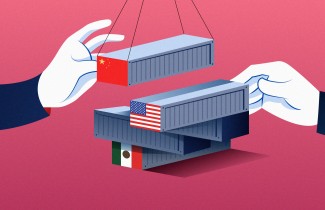What Will the Economy Look Like in 2020?
The Mexican economy is expected to grow at a rate of 0.9% in 2020, far short of the 4% target set by the government, with the added risk of a technical recession if the U.S. external sector continues to contract
Economic activity this year has disappointed. From January to September, there was no cumulative growth compared to the previous year. While it is true that in the first year of any new administration there are delays in the execution of public spending, this year the adjustment to spending and delay have been greater than expected. Additionally, most of the components of aggregate demand have performed negatively.
Both private and public investment fell significantly this year, at a rate not seen since the last international financial crisis of 2009. With regard to public investment, spending has been significantly delayed throughout the year; many of the cuts in public spending announced this year have been in physical investment, but current spending has also decreased.
Moreover, there are several factors that are discouraging private investment: the uncertainty caused by the termination of certain government projects, such as the cancellation of NAIM (the new airport in Texcoco), and the suspension of oil contract auctions, among others; an unfavorable external sector due to the persistent trade war between the U.S. and China that is generating global risk aversion; and the delay in the ratification of the North American Trade Agreement, USMCA, by the U.S. Congress. In addition, interest rates have remained high in Mexico.
Private consumption has slowed this year as a reflection of the slowdown in economic activity. The unemployment rate has already reversed its downward trend and the creation of formal employment has been lower than last year. It should be noted however that the real income of some sectors of the population has improved, due to increases in the minimum wage at the beginning of the year and an inflation rate that has fallen in the center of the Bank of Mexico’s goal limits. This largely explains why consumer confidence has continued to be high.
Finally, the external sector has done well, due to the sustained economic growth in the U.S., which averaged 2% during the year. However, recently there has been a significant decline in Mexico’s manufacturing exports to the neighboring country, especially automotive exports. This contraction reflects the slowdown in U.S. industrial activity as a result of the protectionist policies between China and the U.S. that are slowing the global economy.
Thus, the Mexican economy will probably not grow, or even contract, this year.
What to expect next year?
An uncertain scenario that will depend on the U.S.
The Bank of Mexico recently reduced growth expectations for this and next year. For 2020, annual growth is expected to fall in a range between 0.8% and 1.8%. Although economic activity is expected to rebound next year, there are many downside risks, especially related to the external sector.
The U.S. economy continues to grow and defy the forecasts of some analysts who anticipated an economic recession. The Federal Reserve’s Probit models, which indicated a 30% chance of a recession a couple of months ago, now predict only a 10% probability.
However, downside risks for the U.S. economy persist, especially if we analyze the survey of manufacturing supply executives in the U.S. Purchasing Managers Index, which is currently located at levels below 50 points, suggesting that U.S. industry is in contraction. A marked slowdown in the U.S. economy would have a significant impact on Mexico's growth expectations.
In the medium term, the U.S.-China trade war presents an area of opportunity for Mexico, taking advantage of the situation with regards to the North American Trade Agreement, USMCA. As a result, many Asian companies are expected to migrate to Mexico and thus avoid U.S. protectionist policies.
On the positive side, the federal government recently announced the National Infrastructure Plan, which includes 147 investment projects worth approximately 800 billion pesos. The projects are welcome and should have a favorable impact on growth next year. However, these measures are not enough to revive investment in the country. If the Texcoco airport project were resumed and oil contract auctions reactivated, some of investors’ lost confidence would be recovered.
Moreover, there is an even greater risk, which is related to the evolution of public finances and the Pemex business model. The rating agencies reduced the country outlook at the beginning of the year, especially because of the high indebtedness of the state oil company and have recently expressed their concern about reductions in the country's growth prospects for next year.
It is important for the government to consider measures to safeguard public finances, such as a tax reform. The Savings Fund (FEIP) left by the previous administration is likely to be used in its entirety to compensate for the fall in tax revenues, reflecting lower economic activity and the expectation of reduced revenues for Pemex (due to lower oil prices). The global economic slowdown is reducing international demand for crude oil. In addition, an important part of the federal budget will go to Pemex, which is currently posting substantial losses.
Thus, considering the factors described above, the economy is expected to expand at a rate of 0.9% in 2020, compared to 0.0% this year, but far from the current administration’s established goal of 4%. However, into the mix, I add the high risk of a technical recession if the U.S. foreign sector continues to contract at high rates. It will be important to monitor the negotiations between China and the U.S. closely.



